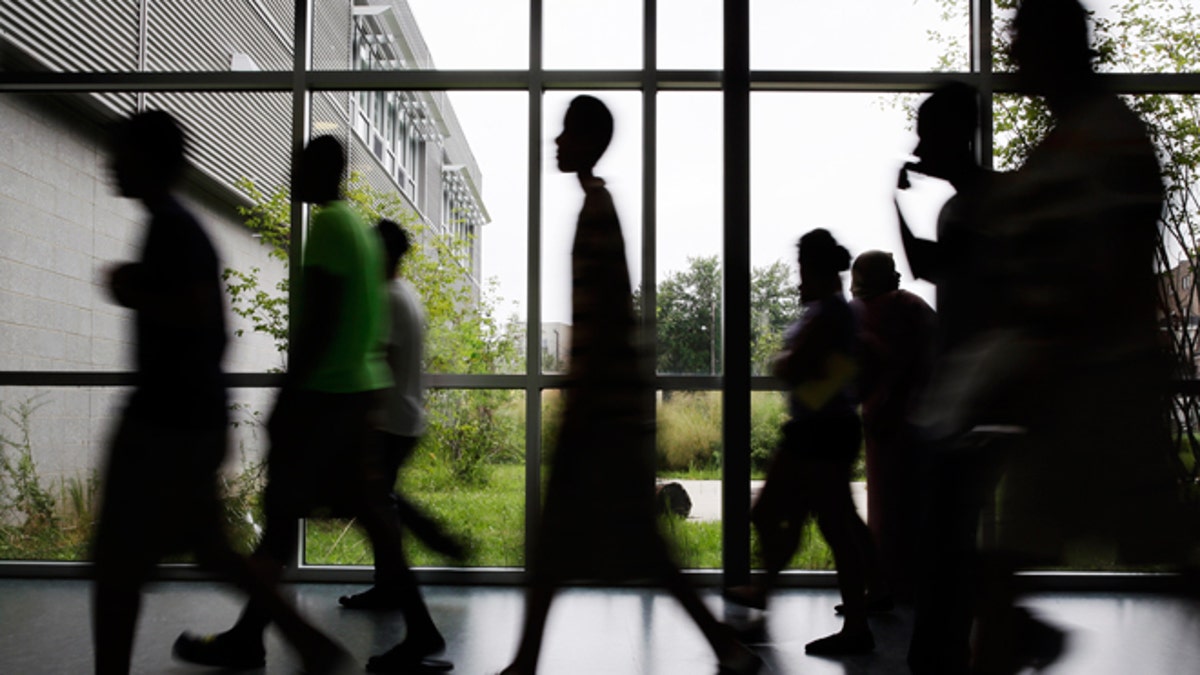
Aug. 29, 2013: Students walk the halls during an open house for incoming freshman and transfer students at Kensington High School for the Creative and Performing Arts in Philadelphia. (AP Photo/Matt Slocum)
The robots are coming – and they may put your friendly neighborhood retail staffer out of work.
Home-improvement superstore Lowe's recently began employing robot sales assistants in some of its stores. The robots can answer questions in multiple languages and take customers directly to what they're looking for.
Lowe's isn't alone. What used to be the stuff of science fiction is now reality. In hotels, hospitals, restaurants and newsrooms, robots are taking jobs that only humans used to do.
Unfortunately, America's schools haven't been paying attention. They're still training students for the very jobs the robots are taking. The basic math, reading and writing skills they teach are no longer enough. Our schools must start teaching children skills that robots can't emulate, like emotional intelligence and problem-solving.
That future will require workers to think creatively, work collaboratively, deepen their emotional IQ, and integrate technology into everything they do.
There's no question that advances in robotics and artificial intelligence will have a significant impact on the labor force – and not just for blue-collar workers.
Johnson & Johnson, for example, recently won FDA approval for Sedasys, which automates the administration of anesthesia for procedures like colonoscopies. Momentum Machines has developed a robot that can make a gourmet hamburger in 10 seconds. A hotel in Silicon Valley uses a robot bellhop to deliver luggage to guests' rooms. Amazon employs robots in its warehouses to speed up deliveries.
The technology research firm Gartner expects that by 2025, one-third of today's jobs will be replaced by machines. University of Oxford researchers think that number will reach 47 percent by 2033.
Will all this lead to a dystopian future, with massive unemployment and machines in charge?
If history is any guide, the answer is no. The industrial age displaced millions who'd earned their livings making things by hand. Agricultural technology allowed farmers to produce far more crops while employing fewer people. Office computers made armies of stenographers obsolete.
But each "job-killing" technological advance also greatly increased productivity and created new job opportunities. The nature of work has changed, but the number of jobs that are out there keeps climbing.
Rather than fight the future, schools should prepare the next generation of workers for it. That future will require workers to think creatively, work collaboratively, deepen their emotional IQ and integrate technology into everything they do.
Unfortunately, even the best public, private and charter schools still maintain an outdated focus on memorization and following directions. They should address the learning priorities of the future instead, and in three major ways.
First, they can embrace project-based learning, which empowers students to develop their creativity and problem-solving skills. Students might be asked to develop public-health responses to disease outbreaks, conduct an archaeological dig, plan bike tours of local historical monuments or even design a school parking lot.
Kids can learn how to work in teams and synthesize knowledge from multiple subject areas to solve real-world problems. These sorts of tasks have far too many variables and unknowns for even the best artificial intelligence to handle.
Second, schools can use social-emotional learning to improve students' emotional intelligence. The approach teaches students how to better understand emotions, develop empathy, foster positive relationships and make responsible decisions.
For example, the 4Rs Program – reading, writing, respect and resolution – incorporates emotional intelligence training and conflict resolution into language arts classes. Students in the program use books to discuss conflict resolution, perspective-taking, community-building, listening and more. Research shows that these students exhibit less aggressive behavior, are more socially competent and experience fewer symptoms of depression and ADHD.
The social-emotional skills that kids learn from these approaches won’t be replicated by robots any time soon. Even the most sophisticated android won't soon be able to express excitement about a product when trying to make a sale or recognize when a colleague is being overworked.
Finally, if we're to beat the robots, we're going to have to join them – or at least know how to work with them.
That means doing more than just sticking technology haphazardly in classrooms. To truly prepare students, schools must regularly make tech an integral part of assignments. In the future, technology – robots included – will become an even more common part of the workplace. Any employee worth his salt will have to understand and manipulate that technology to succeed.
Schools must change to prepare students for this future, rather than continue to educate them for jobs that won't exist.




















